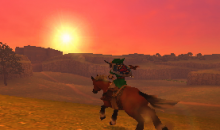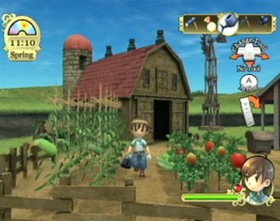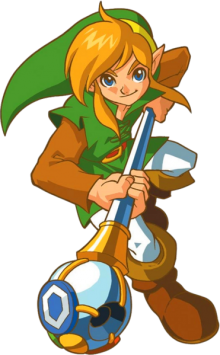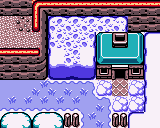The Passage of Time in Hyrule
Posted on August 24 2012 by Hanyou
 A significant number of games offer day/night cycles, and people who play Nintendo games are probably very familiar with the concept. Usually, certain things will only be available at certain times of day, or a number of days have to pass between events in order to complete sidequests.
A significant number of games offer day/night cycles, and people who play Nintendo games are probably very familiar with the concept. Usually, certain things will only be available at certain times of day, or a number of days have to pass between events in order to complete sidequests.
Ocarina of Time certainly made it interesting; shops and houses in towns would be closed at night, the field would harbor new dangers, the overworld at large would offer new opportunities for skulltula harvesting, and most NPCs would acknowledge the passage of time. Ocarina of Time made us aware of how day and night could pass in a game world, but contrary to the real world, time was still static. It didn’t feel like it was moving forward so much as stagnating in a consistent cycle with too few changes over time. This wasn’t a shortcoming, it’s just that having a day/night cycle at all was sort of breaking new ground; infusing those days and nights with gravity and meaning would have to wait two years.
One of the most memorable things about Majora’s Mask — something that hasn’t been revisited in the franchise, and has rarely been revisited in any other franchise — is the three-day cycle. The chief effect of the mechanic on the gameplay and atmosphere is an unprecedented level of consistency and detail. Perhaps more than other Zelda setting, Termina feels like a living, breathing world, filled with people who have their own problems and their own motivations. That their solution is generally to ask for help from a complete stranger is of little consequence; Majora’s Mask offered a sandbox of a different kind, and did a wonderful job of it. What the three-day cycle gave us was a sense of place, a framework with nearly limitless potential. It was in essence about discovering not just places, but events. And surprisingly, this is still a largely new frontier for gaming.
 Thus far, the three-day cycle appears to be one of the best solutions to an age-old problem faced by developers of adventure games, especially games that push NPCs to the forefront: “How do we make this world more believable?” Our lives may seem tedious, but we rarely do the same thing every day. There are nuances, surprises, and events completely beyond our control. But even more importantly, we see time progress steadily. We’re aware of the progression of days, months, seasons, and years, and it affects the minutiae of our daily lives. The Wind Waker presented similar questlines, and its often-overlooked sidequest quality was arguably a match for Majora’s Mask’s. But even The Wind Waker, in spite of its brilliant design, couldn’t do quite what Majora’s Mask did.
Thus far, the three-day cycle appears to be one of the best solutions to an age-old problem faced by developers of adventure games, especially games that push NPCs to the forefront: “How do we make this world more believable?” Our lives may seem tedious, but we rarely do the same thing every day. There are nuances, surprises, and events completely beyond our control. But even more importantly, we see time progress steadily. We’re aware of the progression of days, months, seasons, and years, and it affects the minutiae of our daily lives. The Wind Waker presented similar questlines, and its often-overlooked sidequest quality was arguably a match for Majora’s Mask’s. But even The Wind Waker, in spite of its brilliant design, couldn’t do quite what Majora’s Mask did.
NPCs are very important in Majora’s Mask, of course, because it’s sidequest-driven. But could this depth be accessible without a cycle?
Most games that implement the passage of time do so in a way very similar to Ocarina of Time. Elder Scrolls games certainly utilize time mechanics, but, like Ocarina of Time, generally don’t acknowledge different seasons. Okami let the main character Ammy tackle monsters after dark, and showcased different events at different times of day, but as with Ocarina, it didn’t offer much more than a set cycle. All of this does usually influence how one approaches overworld travel, and can be a positive motivator for exploration. But several non-adventure games — primarily RPGs and sim titles — have an even more thorough implementation of the passage of time.
 Harvest Moon, a farming sim that’s also often called an RPG, is one prominent example. At the most basic level, shops close on certain days, people have birthdays and anniversaries at specific times of the year, and some special events occur which can span several days. There are also seasons. Each season strikes at the core game’s mechanic: Crop-growing is usually one of the best ways to prosper financially, and different seasons yield different crops, with Winter sometimes not yielding any crops at all. Since gameplay is also patterned around the player’s routines, being unable to farm, harvest, mine, or take your animals outside influences all your other actions. The seasonal approach to time forces time management not only within the short span of a day, but also the much longer span of 10 to 30 days that make up a season, depending on the game. Rest, eating, and not overworking are all necessary to prospering, and planting crops early in the season is a must. Further differentiating the seasons are festivals and holidays, which break up the gameplay to keep it from being mundane. Animal Crossing uses time in a similar way, with festivals, unique character interactions, and changing items, albeit tied to the real-world clock.
Harvest Moon, a farming sim that’s also often called an RPG, is one prominent example. At the most basic level, shops close on certain days, people have birthdays and anniversaries at specific times of the year, and some special events occur which can span several days. There are also seasons. Each season strikes at the core game’s mechanic: Crop-growing is usually one of the best ways to prosper financially, and different seasons yield different crops, with Winter sometimes not yielding any crops at all. Since gameplay is also patterned around the player’s routines, being unable to farm, harvest, mine, or take your animals outside influences all your other actions. The seasonal approach to time forces time management not only within the short span of a day, but also the much longer span of 10 to 30 days that make up a season, depending on the game. Rest, eating, and not overworking are all necessary to prospering, and planting crops early in the season is a must. Further differentiating the seasons are festivals and holidays, which break up the gameplay to keep it from being mundane. Animal Crossing uses time in a similar way, with festivals, unique character interactions, and changing items, albeit tied to the real-world clock.
 Pokémon Gold and Silver debuted a time mechanic shortly after Ocarina of Time, and like Animal Crossing, time was bound to the real world. Certain Pokemon could only be caught at night and certain events only took place on particular days. Unlike Harvest Moon and Animal Crossing, this is clearly just an RPG, showing that it’s not just simulations that can benefit from a more detailed time system. With the release of Black and White last year, seasons added yet another layer and helped keep things addictive, with changing environments across the overworld with each season.
Pokémon Gold and Silver debuted a time mechanic shortly after Ocarina of Time, and like Animal Crossing, time was bound to the real world. Certain Pokemon could only be caught at night and certain events only took place on particular days. Unlike Harvest Moon and Animal Crossing, this is clearly just an RPG, showing that it’s not just simulations that can benefit from a more detailed time system. With the release of Black and White last year, seasons added yet another layer and helped keep things addictive, with changing environments across the overworld with each season.
Other games have their own time mechanics. The sleeper Dreamcast hit Shenmue took place over a few in-game months, but certain days have unique events. Near Christmas, decorations and banners start appearing, giving the game a festive environment. It doesn’t affect the gameplay, but it helps make the atmosphere a little more inviting in a game where atmosphere is the star. In Persona 4, the running clock only changes when the player allows it to, but it still forces time management as one of the game’s more difficult aspects, and still gives the player character a sense of place that deepens the narrative, character interactions, and locations.
These are all wildly different games than Zelda, but these examples are also relevant because different games across the franchise have had similar elements, and have used those elements to vary gameplay. No game has yet made time more important than Majora’s Mask, but if simulation games could enrich their worlds with seasons, weeks, and events timed to specific days, why couldn’t Zelda?
 Oracle of Seasons showed that different seasons could radically alter the overworld, offering different ways to explore and adding another layer of depth to the game world. Ocarina of Time and Oracle of Ages used long spans of time in a similar way A Link to the Past used alternate dimensions, and Majora’s Mask compressed that approach over three days, offering more detail and changes that were, realistically, almost as radical. The Wind Waker even demonstrated how visual cues from the overworld can help enhance exploration: at one point, the player has to watch the moon’s cycles to find an elusive ship.
Oracle of Seasons showed that different seasons could radically alter the overworld, offering different ways to explore and adding another layer of depth to the game world. Ocarina of Time and Oracle of Ages used long spans of time in a similar way A Link to the Past used alternate dimensions, and Majora’s Mask compressed that approach over three days, offering more detail and changes that were, realistically, almost as radical. The Wind Waker even demonstrated how visual cues from the overworld can help enhance exploration: at one point, the player has to watch the moon’s cycles to find an elusive ship.
All of this serves to change time from a simple pattern into something more. As with simulation games, it takes advantage of the fundamental element of the Zelda franchise — exploration — and multiplies the possibilities. The puzzle element plays a part, too, as it forces you to directly assess your environment and think laterally. Oracle of Seasons, while not particularly difficult, is especially good about this; it magnifies the light world/dark world mechanic, but does it in a manageable way that’s never overly difficult.
Why not combine these elements? Characters need not have the same schedules every day of the week. Given the relatively few NPCs of Zelda games even today, it shouldn’t be hard to duplicate the general principles of Majora’s Mask over a longer period. The day-to-day changes evident in the three-day cycle could manifest themselves seasonally, and vary by year and by the number of items Link has or how far he is in the main quest. Visual cues, as in The Wind Waker, could round out the experience, hinting to the player that it may be best to change the season or wait for a different day of the week before completing a quest. Absent a means of changing the season or day instantly, quests wouldn’t even have to be “locked,” necessarily, at a certain time of the year — a different season or day can simply necessitate a different approach to a quest, increasing replay value. A Piece of Heart may be available at all times of day and at all seasons, but there’s no reason why it can’t be more difficult to acquire in the winter, buried under snow, or in the summer, precariously positioned under a hornet’s nest.
 Zelda games always feature novel ideas, and always offer new means of exploration. We’ve seen vehicles and radical changes to the overworld alter how we’ve interacted with it. Why not add the fourth dimension to the list of navigational options? It’s intriguing to think of the possibilities. Considering that this niche has still been filled by too few games — especially adventure games — there’s no reason for the developers not to seize on the opportunity and, taking into account the series’ past successes, boldly explore the possibilities offered by a more detailed approach to the passage of time.
Zelda games always feature novel ideas, and always offer new means of exploration. We’ve seen vehicles and radical changes to the overworld alter how we’ve interacted with it. Why not add the fourth dimension to the list of navigational options? It’s intriguing to think of the possibilities. Considering that this niche has still been filled by too few games — especially adventure games — there’s no reason for the developers not to seize on the opportunity and, taking into account the series’ past successes, boldly explore the possibilities offered by a more detailed approach to the passage of time.




